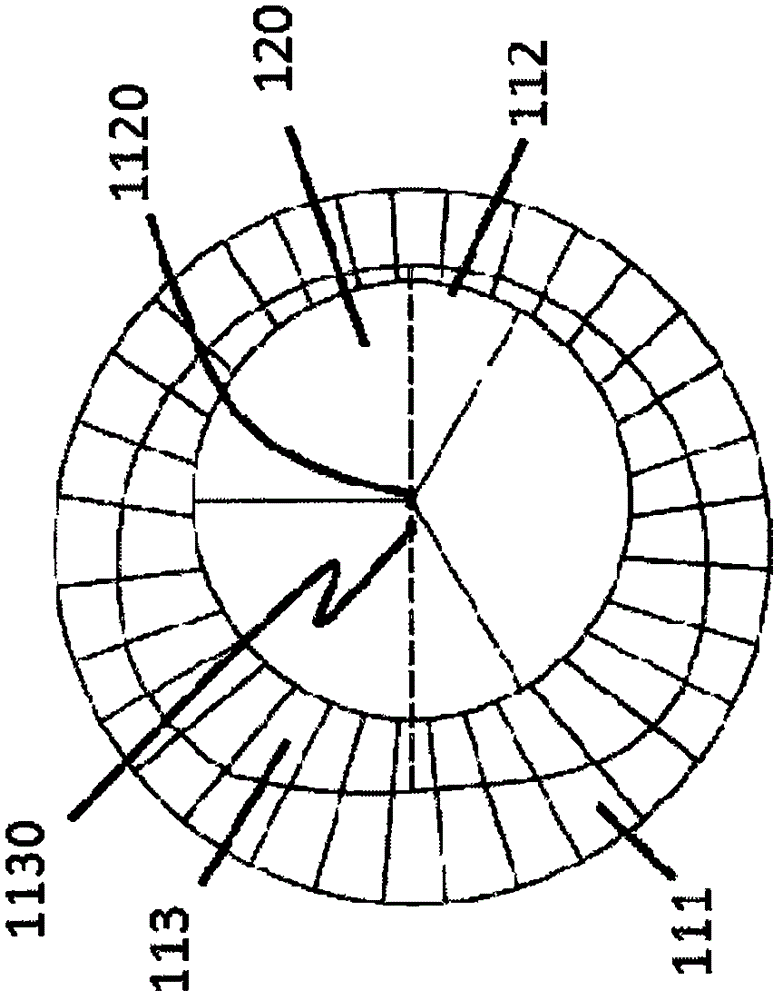Asymmetrical heart valve prosthesis
A heart valve, asymmetric technology, applied in the field of medical devices, can solve problems such as increasing the size of the stent, and achieve the effects of avoiding traction, reducing the pressure of stocking, and reducing the volume
- Summary
- Abstract
- Description
- Claims
- Application Information
AI Technical Summary
Problems solved by technology
Method used
Image
Examples
specific Embodiment 1
[0084] For a long time, whether it is Edwards company or Medtronic company, major valve manufacturers have used enlarged stent-annulus radial expansion ratio to obtain sufficient stent anchoring force, which has been used in the field of aortic valve interventional replacement and pulmonary valve interventional replacement. It has been fully applied and has become a consensus (generally 10%-15% is the ideal circumference expansion ratio). Later, Jenavalve and Symetic applied the leaflet clamping mechanism to their products, and still had a certain expansion ratio for the patient's valve. However, due to the complex physiological structure and disease mechanism of atrioventricular valves (including mitral valve and tricuspid valve), it is often difficult to accurately position and fix the product. The current technologies for atrioventricular valve replacement, such as Edwards, Medtronic and Tiara, all need to provide a certain radial expansion ratio to meet the needs of anchor...
specific Embodiment 2
[0093] In one embodiment, as Figures 6a-6cAs shown, an asymmetric heart valve prosthesis 200 includes a stent 210 and a prosthetic valve 220. The stent 210 includes an atrial segment 211, a support segment 213, and a valve suture segment 212, which is different from fixing an outer frame to an inner frame. In the prior art (CN201480035996.8), in the present invention, the support section 213 is connected with the distal end of the valve sewing section 212, which can greatly reduce the Due to the volume of the gap, it is not easy for blood to stay in the gap, which effectively reduces the generation of thrombosis and is safer. The cross section of the support segment 213 is D-shaped, the atrium segment 211 is connected with the distal end portion of the valve sewing segment 212, and the artificial valve 220 is fixedly connected to the valve sewing segment 212. On the cross section perpendicular to the central axis of the prosthetic valve 220, the center of the valve sewing se...
specific Embodiment 3
[0099] like Figure 7a Illustrated, an asymmetric heart valve prosthesis 300 includes a stent 310 and a prosthetic valve (not shown), the stent 310 including an atrial segment 311, a support segment 313 and a valve sewn segment 312, the support segment 313 being connected to The distal end portion of the valve sewing segment 312 is connected, the cross section of the support segment 313 is D-shaped, the atrial segment 311 is connected to the distal end portion of the valve sewing segment 312, and the artificial valve 320 is It is fixedly connected to the valve sewing section 312, and on a cross section perpendicular to the central axis of the artificial valve 320, the center of the valve sewing section 312 is set at the center of the support section 313 and the Between the “D”-shaped arc segments of the support segment 313, the cross-sectional area of the valve sewing segment 312 is smaller than the cross-sectional area of the patient’s native valve annulus, and in the fre...
PUM
 Login to View More
Login to View More Abstract
Description
Claims
Application Information
 Login to View More
Login to View More - R&D Engineer
- R&D Manager
- IP Professional
- Industry Leading Data Capabilities
- Powerful AI technology
- Patent DNA Extraction
Browse by: Latest US Patents, China's latest patents, Technical Efficacy Thesaurus, Application Domain, Technology Topic, Popular Technical Reports.
© 2024 PatSnap. All rights reserved.Legal|Privacy policy|Modern Slavery Act Transparency Statement|Sitemap|About US| Contact US: help@patsnap.com










